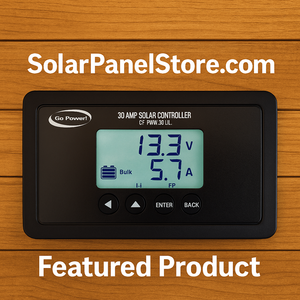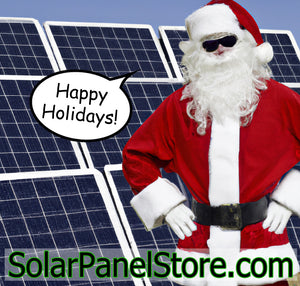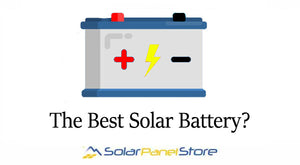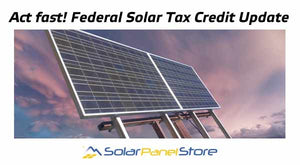Solar Panel Store Blog

Featured Product - Go Power! 30A 12V Controller with Blue Tooth - GP-SB-PWM-30BT
It’s been a while since we updated the blog—sorry about that. As summer kicks into gear and the adventures start rolling in, we've been hearing a lot of questions about charge controllers for RVs and small off-grid setups. So we figured it’s a good time to highlight one of our most popular and reliable controllers this season: the GP-SB-PWM-30BT from Go Power.
If you're living in an RV or managing a small off-grid solar setup, you've probably spent time wondering if your batteries are charging properly. The Go Power GP-SB-PWM-30-BT solar controller is one of those behind-the-scenes devices that quietly makes everything work better. It protects your batteries from overcharging and helps you get the most out of your solar panels, all without needing much from you.
This 12-volt controller can handle up to 30 amps of solar input. It works with all the usual battery types including AGM, gel, flooded, and lithium. The four-stage charging system adjusts automatically, so your batteries get the charge they need without being overworked.
One of the best features is the Bluetooth app. You can check your system’s performance from your phone, seeing real-time charging status, battery levels, and more without digging around in your rig. It’s especially helpful if your controller is mounted somewhere inconvenient or if you just like having everything at your fingertips.
The unit is built to handle tough conditions, including extreme temperatures, and it’s got protections built in to guard against short circuits, overvoltage, and reversed connections. It’s compact, has a backlit screen for easy reading, and mounts flush for a clean look.
Whether you’re traveling full-time or just want a solid setup at your off-grid cabin, this solar controller adds a level of reliability that’s easy to appreciate. It quietly keeps your power flowing so you can focus on enjoying the view, not worrying about your batteries.
You can find this on the site for just $107.99! - Go Power! 30A 12V 30 AMP Single Bank Controller with Blue Tooth - GP-SB-PWM-30BT
If you have any questions about this product, or anything else solar electric related and want to speak with a person, we are always happy to help! Email us at info@solarpanelstore.com or give us a call at 800.766.7644.
- Loren Geist

Happy Holidays! 2022 is almost wrapped up!
Dear valued customers and partners,
As the holiday season approaches, we at SolarPanelStore.com would like to take a moment to thank you for your support throughout the year. It has been a challenging year for everyone, but we are grateful to have had the opportunity to continue serving you and helping you make the switch to renewable energy.
Renewable energy is more important now than ever before. As we work to combat climate change and protect our planet for future generations, the shift to clean, sustainable sources of energy is crucial. Solar panels are a key part of this transition, providing a reliable and renewable source of power that can help reduce our reliance on fossil fuels.
We are truly grateful to have such wonderful customers and partners who share our commitment to a better, more sustainable future. Your support and partnership have been invaluable, and we look forward to continuing to work together in the coming year.
From all of us at SolarPanelStore.com, we wish you a happy holiday season and a prosperous new year. Thank you for choosing us as your partner in the transition to renewable energy.
Sincerely, Loren and Dan (Team SolarPanelStore.com)
- Loren Geist
- Tags: solar blog Solar Info

Which type of battery is best for solar applications?
There are several types of batteries that can be used for solar power systems, but the best type of battery will depend on your specific needs and circumstances. Some common options include lead-acid batteries, lithium-ion batteries, and nickel-metal hydride batteries. Each of these types of batteries has its own advantages and disadvantages, so it's important to consider factors such as cost, performance, and maintenance requirements when choosing the right battery for your solar power system.Lead-acid batteries are the most common type of battery used in solar power systems. They are relatively inexpensive and have a long life span, but they can be heavy and can lose their charge quickly if not used regularly. It's common to use sealed or wet style batteries for renewable energy applications.
The main difference between sealed lead-acid batteries and wet lead-acid batteries is the way in which the electrolyte solution is contained. In sealed lead-acid batteries, the electrolyte solution is absorbed into a sponge-like material, whereas in wet lead-acid batteries, the electrolyte solution is held in a separate compartment within the battery.
Sealed lead-acid batteries are also known as "maintenance-free" or "valve-regulated" batteries because they do not require regular maintenance or the addition of electrolyte solution. Wet lead-acid batteries, on the other hand, require regular checking and topping up of the electrolyte solution to ensure that the battery remains in good working order.
Sealed lead-acid batteries are generally more expensive than wet lead-acid batteries, but they are more convenient to use and require less maintenance.
Lithium-ion batteries are becoming increasingly popular for use in solar power systems because they are lightweight, have a high energy density, and can hold their charge for a long time. However, they are also more expensive than lead-acid batteries.
Nickel-metal hydride batteries are similar to lithium-ion batteries in that they are lightweight and have a high energy density. They are also relatively inexpensive, but they may not last as long as lithium-ion batteries.
The team here at SolarPanelStore.com has been working with batteries for off-grid and grid-hybrid systems for many years, and we have a lot of experience that we are happy to share with our customers. Please feel free to contact us for questions about batteries or to help with any kind of solar application!
Act fast! A Federal Solar Tax Credit Update and Reminder
Costs of solar electric systems have dropped dramatically over the past few years, but utility rebates, and incentives like the Federal Tax Credit can greatly increase your solar systems ROI. If you want to take advantage of the current 30% Federal Tax Credit (also known as ITC, or Investment Tax Credit), now is the time to start or complete your solar and battery projects. To be eligible for the tax credit, your solar project should be fully installed and paid for in 2019.Systems completed in 2020 will be eligible for 26% deduction of the cost of the system from federal taxes, down to 22% in 2020, and unfortunately right now it looks like 2022 and beyond, only owners of commercial solar PV systems will be eligible for a 10% tax credit, and residential owners will not be eligible for any tax credits.
One of our favorite websites for federal and local rebate programs and tax credit updates is DSIREUSA.org.
- Loren Geist
- Tags: Solar Incentives Solar Panel Rebates Solar Systems Tax Credit




